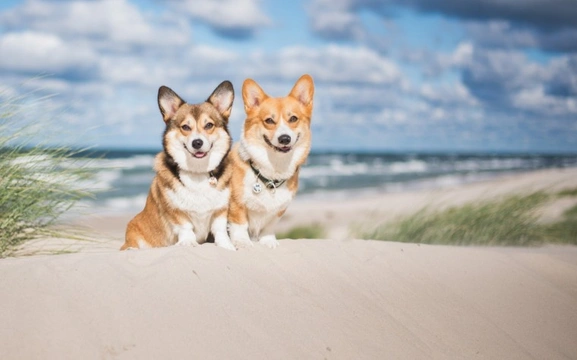
How do dogs moderate their temperature in summer?
One thing that most dog owners know is that dogs don’t sweat in the same way that people do; after all, whilst most of us are familiar with our dogs smelling bad in any one of around a hundred different ways, they’ve never come up to us after a hectic session of haring around at the park reeking of sweat and curdling the air around them!
Naturally this doesn’t mean that dogs simply don’t get too hot, and overheating and particularly, heatstroke can pose a significant threat to dogs in the summer, which all owners should take pains to safeguard against.
Dogs simply manage and moderate their body temperatures in different ways than we as humans do, and by recognising how they keep their cool and how to help them to cool down if they get too hot, you can keep your dog comfortable and safe all summer long.
So, how do dogs moderate their temperatures, and how does the dog’s anatomy and bodily functions help them to keep their cool? This article will explain the basics of how dogs cool down and how they maintain a comfortable temperature. Read on to learn more.
Panting and the exchange of hot air for cool
Dogs pant a lot when they’re hot, whether that’s due to hot weather, exertion, or a combination of both. Panting serves two purposes when it comes to cooling your dog down, which firstly, is the exchange of hot air from inside of the lungs for cooler air from the environment. The faster your dog pants, the faster this exchange happens, which is why dogs pant more the hotter they get!
It also draws cooler air over the capillary-rich surfaces of the tongue and inside of the dog’s mouth to cool the whole body.
Panting and evaporation
Secondly, panting causes the moisture inside of your dog’s mouth to evaporate, cooling as it does so. When a dog is panting they will often seek out a drink, because this also helps replace the water lost through evaporation to keep them cool.
Drinking cool water
Drinking cool water also of course helps to keep your dog cool in itself. It helps to cool the body from within, and vitally, ensures that your dog doesn’t become dehydrated, as a lot of water is lost by the body as part of its various cooling processes.
A dog that is dehydrated won’t have enough moisture in their body to keep their cool, as well as running the risk of all of the primary effects of dehydration too, and so it is vital to provide your dog with continual access to fresh water at all times, and remember they’ll need to drink more on hot days.
Water in your dog’s bowl will also evaporate faster when it is hot too, and this is particularly true for bowls that are wide and shallow, rather than somewhat deeper.
Sweating through their paws
We all know that dogs don’t sweat like people do, but many people think that dogs don’t sweat at all, which is inaccurate. Dogs do sweat, but only a small amount and not from their armpits. It is only the pads of the paws (and to an even lesser extent, via the surface of the nose) that dogs sweat, and only to a very limited extent.
Dogs don’t sweat from their paws enough to provide a huge amount of cooling, but every little helps.
Limiting activity
Nobody tends to feel particularly energetic in really hot weather, and this is true for dogs too, which helps to ensure that they do not overheat by adding exertion to high temperatures too. It is an instinct for self-preservation that will make your dog a lot lazier on hot days; but they will still need to be exercised at some point!
Walk your dog at the coolest times of the day, and remember to avoid pavements that might be hot, which can easily burn your dog’s paws.
Seeking shade
Dogs will also seek out shady spots and will not spend much time out in the full heat of the sun out of choice.
Giving your dog as much freedom of movement as possible when it comes to picking shady spots is important. For instance, restricting your dog to one room of the house can be a problem if the room starts cool but then heats up as the sun moves around later on in the day.
Lying on cool surfaces
Finally, dogs will often seek out cool surfaces like the tiles of the bathroom or kitchen floor to lie on in hot weather, as having a large amount of their body in contact with cooler surfaces will help to cool their whole body down.
This is part of the reason why dogs often lie flat out in hot weather; not just due to laziness but to maximise the amount of their body in contact with the cooler surface.



